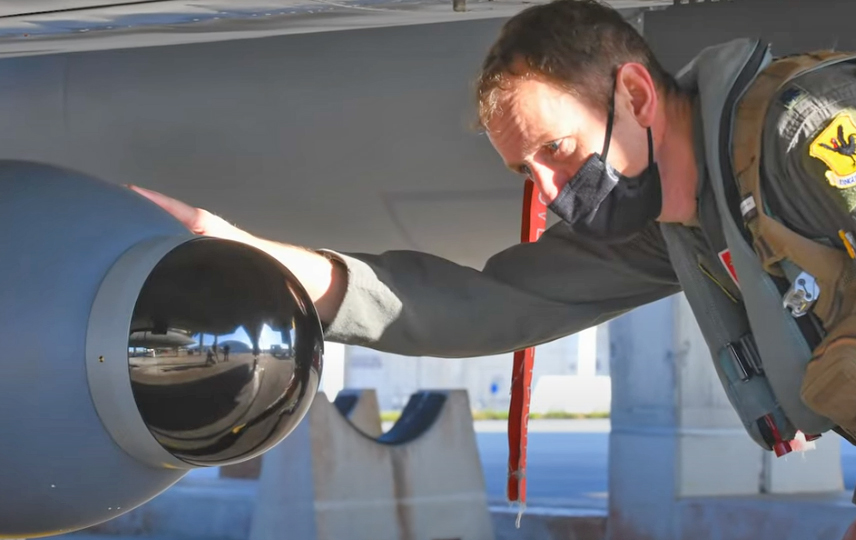
USAF Photos: Crolley, B., “Around the Air Force: USAFE 80th Anniversary, Legion Pod Infrared Tech, Airmen Deploy to Fight COVID-19,” Air Force TV, Air Force News Service, published 18 February 2022; URL: https://www.af.mil/News/Article-Display/Article/2938644/around-the-air-force-usafe-80th-anniversary-legion-pod-infrared-tech-airmen-dep, accessed 18 February 2022.
Development of modern stealth technologies in the United States began in 1958, when earlier attempts to prevent radar tracking of its U-2 spy planes during the Cold War by the Soviet Union had been unsuccessful. “Radar” which is short for RAdio Detection And Ranging, uses radio waves that are sent out as short pulses which may be reflected by objects in their path, in part reflecting back to the radar which determines the distance (ranging), direction, or speed of objects; such as airplanes, rockets, and ships.
Aerospace engineers turned to developing a spaecific shape for planes that tended to reduce detection by redirecting the radar signals. The F-117 Nighthawk, with its sharp edges and flat surfaces, was the first operational aircraft specifically designed around stealth technology. That capability was enhanced with the development of radiation-absorbent material that reduced or blocked radar signals from reflecting off the surface of aircraft, such as on the B-2 stealth bomber.
Technology has been the primary source of military innovation throughout history. It drives changes in warfare more than any other factor. We saw this in the rapid development of aviation in World War I, and the development of the V-1 rocket and the atomic bomb in World War II. Thus, as one country develops a capability, another develops an ability to counter or copy the technology to maintain an equal means of defense and offense.
The United States had stated that the F-35 stealth fighter would be operational in 2010, but when the Wall Street Journal reported in 2009 that computer spies, allegedly Chinese, had penetrated the database of the Joint Strike Fighter program and acquired terabytes of secret information the program got pushed back by five years and China developed the Shenyang J-31; which China will offer to its allies.
At $80-million per aircraft, and a 66-year lifecycle, the United States and its allies cannot afford to abandon the latest design, and try to come up with another aircraft just to keep ahead of any potential threats. Eventually, the F-35 will replace all AV-8B Harriers, F-15 Eagles F-16 Vipers, F-18 Hornets, and the EA-6B Prowler.
It can take decades for the older aircraft to be replaced with the new F-35, by which time the F-35 will be old outdated technology. So how do we keep our technological edge and superiority? By developing new technologies in the form of upgrades and add-ons. Lockheed-Martin has produced one such breakthrough in the form of a pod that can be mounted on a “hardpoint” weapons pylon of older aircraft to give them a tactical advantage.
The Legion Pod is the latest example of targeting and sensing innovation, which utilizes a combination of advanced technologies, and provides a “legion” of capabilities unlike any other system. One way to neutralize radar is to send jamming signals on the same frequency as the radar. Legion Pod is a multi-function sensor system that supports collaborative targeting operations in radar-denied environments. Even if stealth technology makes our aircraft invisible to others, they still need to see who is out there and know where the enemy targets are located. However, as soon as they turn on their radar systems, they reveal themselves to enemy weapons.
The Legion Pod is based on Infrared Search and Track (IRST) which is one way to detect and track objects that emit electromagnetic radiation – or infrared signatures. What makes it unique is its “passive” nature – meaning it can act without emitting any radiation of its own. The infrared sensor visualizes a heat signature, without sending out any signal. Aircraft can reflect heat from the sun during the day, while the warm engines stand out in the cold night sky. Additionally, at supersonic speeds, the leading edge and other parts of the aircraft build-up heat from the friction of the air, and heat from the engines are hard to hide.
Even if the Legion Pod is only on one aircraft, once its infrared sensors has identified targets in the battle zone, it can transmit that information to other aircraft in the formation. The range on the Legion Pod is great enough where our forces have the ability to strike before being detected.
The Legion Pod has been flown in testing and in exercises on F-15s and F-16s, and in a recent exercise the Legion Pod was selected as the winner of the U.S. Air Force’s F-15C IRST competition.
Currently the Legion Pod is completing review with the Air Force Air Combat Command (ACC). Major Hermanski, ACC’s F-15 requirements branch chief said in a Feb. 17 Armed Forces Dispatch article that, “This pod is the next step for countering jamming technology and allowing our warfighters to fight and track the enemy in contested environments.” In the mid-2000s, a similar system was selected as the winner in the U.S. Navy’s F/A-18E/F IRST competition. In that configuration, the system was mounted in the F/A-18E/F’s fuel tank; production of that system is underway.
In a recent flight test, General Atomics Aeronautical Systems integrated a Legion Pod onto an Avenger Remotely Piloted Aircraft (RPA) demonstrating enhanced autonomous sensing capabilities for an unmanned aircraft.
This Legionnaire is happy to know that there is a Legion Pod out there, protecting our pilots and military aircraft.












